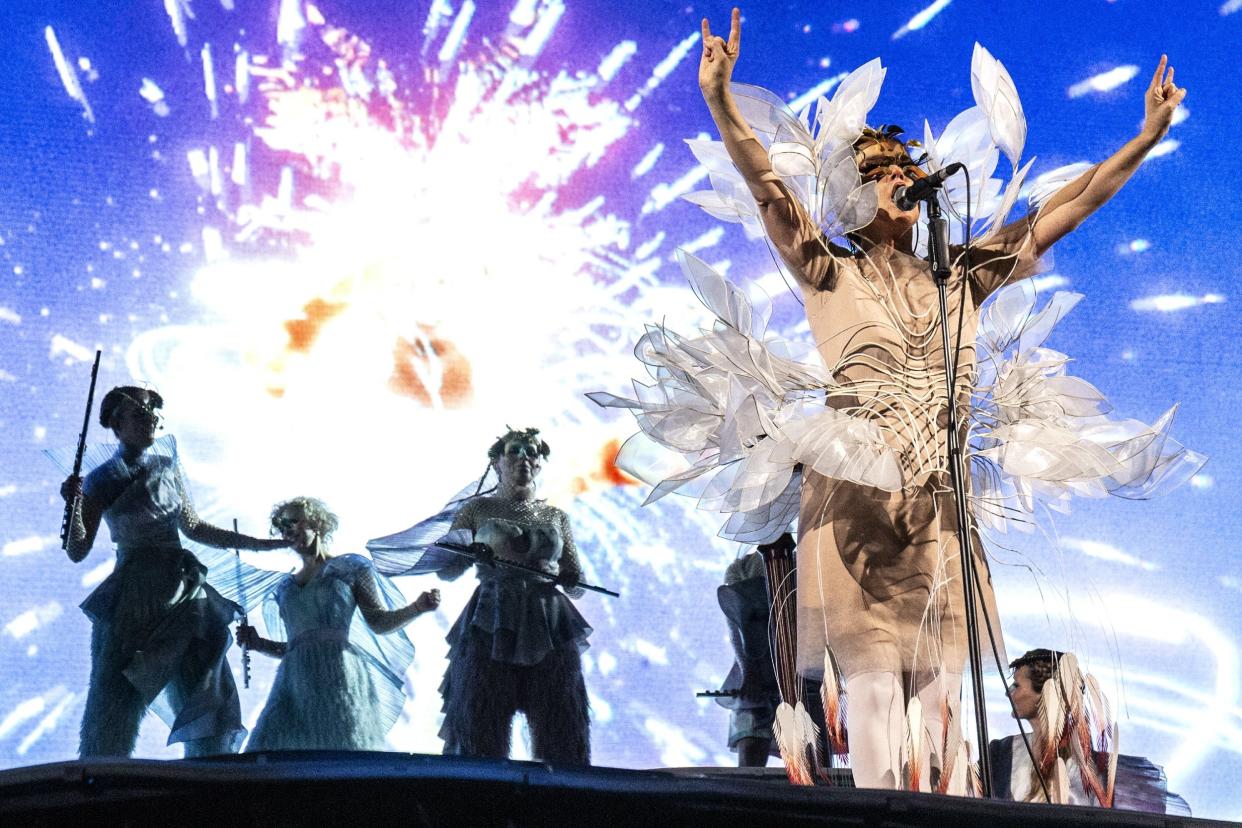Bjork review, O2 Arena: Icelandic artist breathes rich, slippery life into London’s most barren concert space

In her teens, Bjork swore an oath never to perform in an arena. The punk who rejoiced in her physical contact with nature and the messy scuffle of human connection had seen how these vast, industrial spaces sucked the life out of music, leaving dead air between artist and audience. Arenas bored her.
But her 2017 album, Utopia, hymned the human race’s potential to save the planet we’ve been poisoning. “A territorial hope affair,” is how she described its lush layers of flute, harp, synths and birdsong. What better way to animate that inspiring concept than to breathe rich, slippery life into the aridity of London’s largest and most barren concert space?
High-definition birdsong is already darting around the O2 as I take my seat; the innovative sound system makes it sound as though exotic birds are swooping over my head, or hiding in the gloomy corners. The show opens with an earthy 20-minute set from the Hamrahlid Choir, dressed in traditional folk costumes as they delivering hearty traditional Icelandic songs and choral arrangements of Bjork’s “Sonnets/Unrealities XI”. The unadorned human voices serve to warm and anchor the atmosphere before the night’s “digital theatre” begins, where Bjork performs most of Utopia with a sequence of Tobias Gremmler’s phantasmagoric digital art projected onto screens around her.
I had been wary of this high-tech, high-definition idea. Could such crisp, computer-generated lines summon the intense, organic sensory kick Bjork was after? In the words of one woman behind me: “OH MY GOD, YES!”
It feels like being in a mutant rainforest aboard a spaceship. Gremmler’s fertile imagery conjures the virtual hyperreality of orchids, galaxies, bacteria, faces, forests, fungi and foetuses. It is the most immersive and intoxicating visual experience I have experienced in such an inorganic space. People gasp, giggle, sigh. I realise that suspicion of Bjork’s approach is like being suspicious of the amazing film tech that David Attenborough uses in order to bring the intimate detail of previously unknown species into our living rooms.
On a glowing stage inspired by oyster mushrooms, Bjork is surrounded by her harpist, choir and seven female flautists. The sound places an emphasis on the breath – I feel my own lungs align with the drifting rhythm. At one point, two giant organ pipes are lowered down and the humid air of an E flat and a B-flat major yawn through them for five minutes. The soft, deep vibrations make our soft tissue wobble.
I have to google the other instruments afterwards: a xylosynth, an aluphone (the bells Evelyn Glennie used at the opening ceremony for the London 2012 Olympics), a piezoelectric violin made by Monad design studio, and a segulharpa (with steel strings that interact with the magnetic fields created by the internal analog circuitry). Most glorious are the water drums played by Austrian Manu Delago – I yearn to get my hands into the tank in front of him, full of strange brown shapes resembling giant walnut shells. He strikes them, splashes them, then slowly upends them with the wonder of a toddler at bath time.
Bjork goes into a quirky wigwam of a reverb chamber to throw her own volcanic lung capacity into a couple of the evening’s only older tracks: mutant reincarnations of “Show Me Forgiveness” and “Venus as a Boy” (neither of which she has performed since 2011). The technique shifts the show’s scale again, drawing us into the strangely private/public space. At 53, she can still sound like an overwhelmed or over-excited kid. The only other big old hit, “Isobel”, is a front-of-stage belter.
The only flaw is the lack of clarity in Bjork’s own vocals. Her costume – with its wrinkled mask and strange shoulder-wings – remind me of a bat’s anatomy. I think of echolocation and how Bjork bounces sound and feeling off the walls, just like a bat. It’s just a shame I can’t hear her words with a bat’s precision. Many in the audience aren’t completely familiar with Utopia, and they strain to hear lyrics that express Bjork’s fresh embrace of feminism – her newfound openness to love in the wake of her separation from long-term partner Matthew Barney.
But she shivers the thrill of new love into “The Gate” and spits crisp fury into “Tabula Rasa”: “For my children,” she sings, “Let’s clean up/ Break the chain of the f***ups of the fathers/ It is time/ For us women to rise and not just take it lying down/ It is time/The world is listening/ Oh, how I love you/ Embarrassed to pass this mess over to you…” After this, the screens behind her begin to show images of Bjork as a superhero – muscular, winged and full of fire.
Greta Thunberg then appears on our screens with a recorded speech calling for our solidarity in her fight against climate change. She asks us to follow the children and change the system. By releasing our own inner children and revolutionising the standard concert system, Bjork makes this seem possible. In a projected text, she reminds us that it is time for nature and technology to come together in one “song”.
I leave feeling a little giddy. To paraphrase Bjork’s “Jorga” (which she doesn’t play), it’s as though a landscape has passed through me. I watch a couple in the queue ahead of me slip their O2-bought plastic water bottles into their bags. Maybe they’ll start reusing them today. Maybe they’ll use them to make water drums.
Read more
The 50 best albums of the decade
Album reviews: Beck – Hyperspace and Lady Antebellum – Ocean
Celine Dion’s Courage is let down by vague and inauthentic songs

 Yahoo News
Yahoo News 
